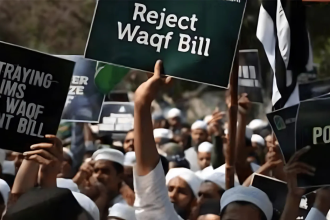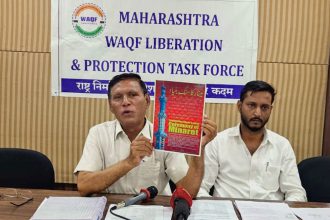As the world observed International Day for Monuments and Sites (World Heritage Day)on Friday, an uneasy silence echoed across Delhi’s forgotten corners—ancient mosques, crumbling shrines, and overgrown graveyards once alive with community and culture.
At least 156 of these historic sites, many dating back to the Mughal era, are now the battlegrounds of a contentious turf war—between the Archaeological Survey of India (ASI) and the Delhi Waqf Board.
On the surface, this appears to be a technical dispute about land and jurisdiction. But scratch deeper and it reveals a crisis at the intersection of heritage, law, and religious identity in India’s capital.
The ASI maintains that these sites are of historical significance, protected under Indian law to safeguard the architectural and archaeological legacy. The Delhi Waqf Board counters that these are waqf properties—religious endowments created centuries ago to serve the Muslim community.
These are not just stones and domes, the Board insists. They are sacred spaces still imbued with spiritual and communal relevance. According to the Waqf Board, formal government records, including gazette notifications, clearly list these as waqf properties—38 mosques, 16 graveyards, and dozens of shrines and dargahs among them.
Yet, today, many of these monuments have been sealed off from the very communities that once cared for them. Worship has been banned in several mosques. Access to graveyards has been restricted. And the echo of prayer has been replaced by the creak of rusted gates and the hush of bureaucratic dispute.
The conflict first came to light through a series of Right to Information (RTI) applications this writer filed over the past decade. In 2010, the Delhi Waqf Board acknowledged in writing that 158 of its registered properties were under the unauthorised control of the ASI.
The figures remained nearly the same in a 2019 RTI response—156 properties, the Board said, were still being held without consent by the heritage body.
What prompted the ASI to lay claim to these graveyards and mosques? And at what cost has this historical preservation come?
When these questions were posed to Hafiz Mahfuz Muhammad, then a Section Officer in the Delhi Waqf Board, in October 2020, his answer was blunt: “There has been no change in the status of these properties so far. The information you have can be accepted as accurate.”
The ASI, for its part, has remained tight-lipped. In a rare comment, Dr. B.R. Mani—then Additional Director General of the ASI—told BBC Hindi: “Does the government ever commit illegal encroachment?”
He added: “The ASI only maintains sites of historical significance. It’s possible that some of the waqf properties include graveyards linked to historical heritage—but otherwise, why would we be interested in a graveyard?”
Legal Threat: Waqf Act 2025
The latest blow to the Waqf Board’s claim comes from a legal provision in the newly introduced Waqf Act 2025.
Section 3D of the amended legislation delivers a decisive verdict: any waqf declaration made for a property already listed as a protected monument under either the 1904 or 1958 Ancient Monuments Acts shall be deemed void.
This means the ASI’s authority takes precedence.
If a site was protected at the time the waqf status was declared, the declaration stands cancelled. The clause essentially strips waqf identity from any ASI-designated site—many of which are centuries-old mosques, shrines, and graveyards that continue to carry religious significance for local Muslim communities.
The implications are massive. According to the Joint Parliamentary Committee (JPC) on the Waqf Bill, the ASI currently oversees at least 250 monuments across India that are also officially registered as waqf properties. In Delhi alone, the ASI recently informed the JPC that the Waqf Board had laid claim to 120 such sites.
Once the Waqf Act 2025 is enforced, all of these claims risk legal extinction.
Beyond the legalese, it is the local communities that have borne the brunt of this conflict. For generations, families have offered Friday prayers in these mosques, buried loved ones in adjoining graveyards, and hosted spiritual gatherings in shrines now closed or heavily restricted.
For them, these are not just archaeological artefacts but living heritage. Their erasure from these spaces has led to alienation, resentment, and an enduring sense of loss.
Many allege that the ASI’s preservation efforts come with a subtle erasure of religious identity—no longer allowing namaz in mosques or restricting the use of waqf graveyards under the pretext of conservation.
In some cases, tombs have reportedly been desecrated or vandalised due to a lack of local guardianship and community oversight.
What began as a preservation mission is increasingly viewed as a state-sponsored displacement of religious heritage.
A Question of Bias?
The ASI’s neutrality, too, has come under scrutiny. In recent parliamentary proceedings, Hyderabad MP Asaduddin Owaisi accused the government of turning the ASI into a “puppet of Hindutva ideology.”
Citing negligence in the upkeep of monuments like the Taj Mahal (a UNESCO World Heritage Site)—which he claimed was suffering from cracks and water seepage—Owaisi alleged that the neglect was deliberate and ideologically motivated.
Whether or not one agrees with his charge, the question remains: how should a secular state manage sacred heritage?
India, a country with a civilisational past as vast as its subcontinental spread, finds itself at a crossroads. Heritage preservation is no doubt important. But when such preservation comes at the cost of worship, community identity, and spiritual continuity, the balance tilts precariously.
The battle over Delhi’s waqf sites is not merely about bricks and mortar—it’s about belonging, memory, and rights. As the world celebrates World Heritage Day this April 18, it is worth asking: whose heritage are we preserving? And who gets left behind in the process?
In the silent shadows of these disputed sites lies the answer—waiting to be acknowledged before it’s too late.
Afroz Alam Sahil is a journalist and author. He can be contacted at @afrozsahil on X.




